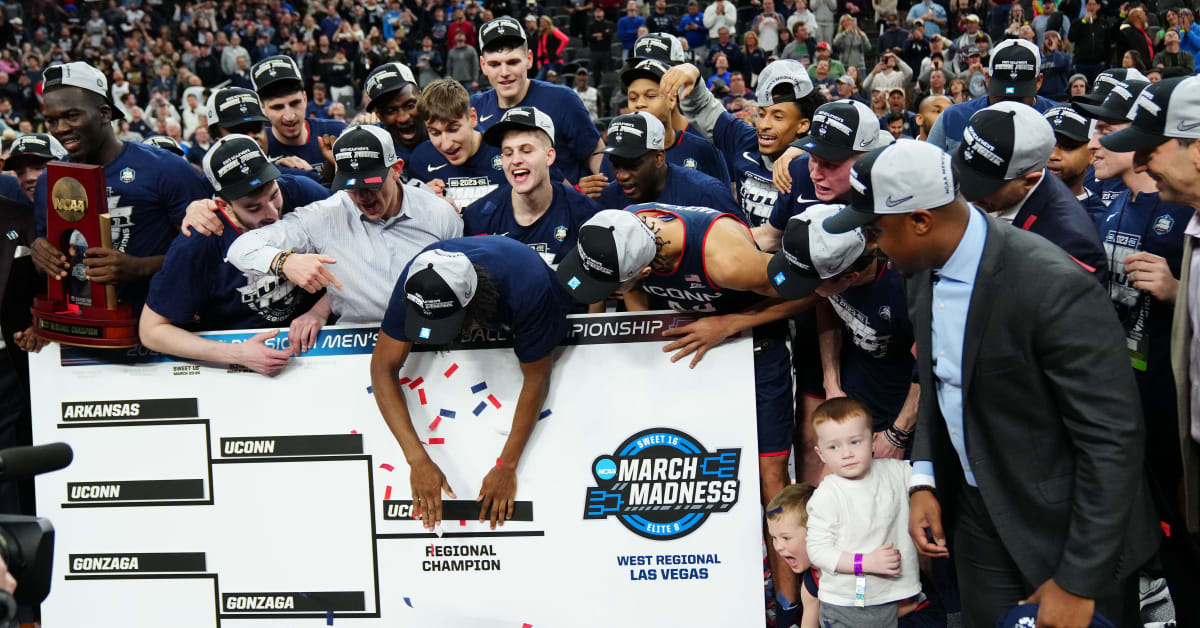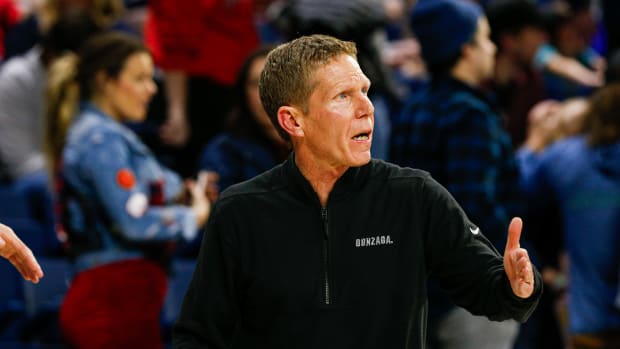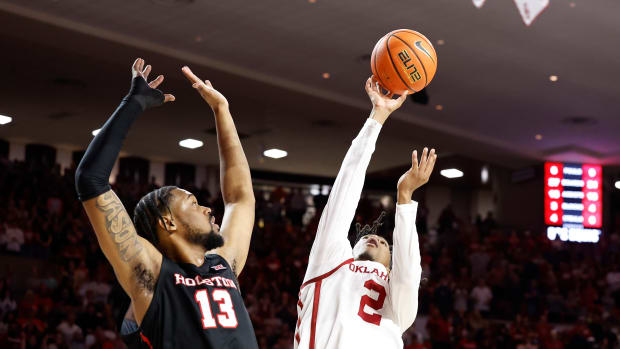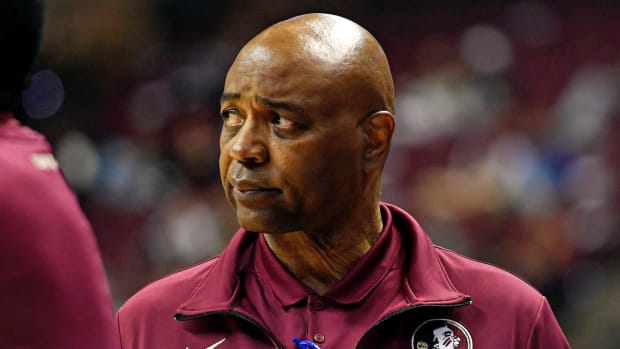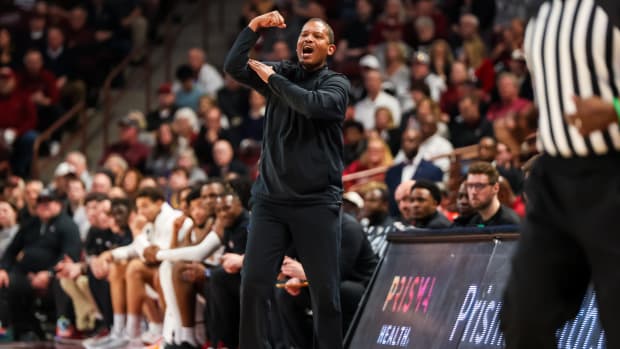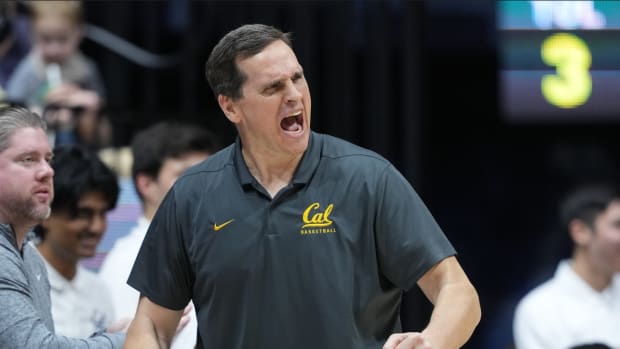SI’s Final Four Predictions: These Two Teams Will Play for the Men’s National Title
Florida Atlantic vs. San Diego State
Either Florida Atlantic or San Diego State is going to play for the national championship Monday night. In men’s basketball. Not beach volleyball nor water polo. March has indeed been Madness.
They’re going crazy in La Jolla and Boca Raton, presumably. If the folks there can tear themselves away from the beach.
Neither school has been to a Final Four until now. Neither school’s conference—Conference USA for the Owls, the Mountain West from the Aztecs—has put a team in the title game. But here we are, preparing for a barrier-breaking Final Four semifinal.
While this is, indeed, an improbable development, let’s not consider either team a fluke. Both won their league’s regular-season and tournament titles. FAU has 35 victories in 38 games; SDSU has 31 wins in 37 games. They’ve been consistently excellent all season, and this should be a very good game.
How they got here
Florida Atlantic was given a disrespectful No. 9 seed by the selection committee, despite being the No. 13 team in the NCAA’s own NET rankings, No. 23 in the Pomeroy ratings and No. 25 in the AP poll. But that seed turned out to be more of a problem for the teams in the Owls’ path than the Owls themselves.
Given a tough opening matchup with Memphis (which also deserved better than its No. 8 seed), FAU pulled out a one-point win that went down to the wire and was not without late controversy over a timeout that was granted instead of a jump ball. From there, the Owls were blessed with a second-round game against No. 16 seed Fairleigh Dickinson, which had slayed No. 1 Purdue—that game was in doubt as well until a late 12–2 FAU run.
It wasn’t until the Owls got to Madison Square Garden that they began playing their best basketball of the tournament. They exerted their will on Tennessee in the late stages of a grinding, seven-point victory, before outlasting Kansas State in a 79–76 thriller to reach the Final Four.
Fifth-seeded San Diego State also had to win a tight first-round game against dangerous College of Charleston, leading most of the way but then winding up in a tie game with less than three minutes to play. The Aztecs held Charleston without a field goal from 3:27 until 19 seconds remained to pull that out, then got their own upset break when second-round opponent Furman took down No. 4 Virginia. SDSU rolled over the Paladins and into the Sweet 16 in Louisville.
That’s when San Diego State sent the tournament into a tizzy by knocking off the overall No. 1 seed, Alabama. Down nine in the second half, the Aztecs mounted a gritty rally that shocked the Crimson Tide. In an inartistic but tense regional final against Creighton, the Aztecs overcame a seven-point second-half deficit, winning on a controversial foul call and free throw with 1.2 seconds left.
Best individual matchup
Both these teams win by committee, going nine-deep and substituting players in bunches, so there aren’t any superstars on either side. SDSU’s leading scorer, Matt Bradley, averages just 12.5 points per game. FAU’s top guy, Johnell Davis, averages 13.9.

Bradley has played a total of 971 minutes for the Aztecs so far this season.
Jordan Prather/USA TODAY Sports
The 6'4" Davis is the guy who can make the toughest baskets for FAU, able to finish off the dribble with either hand or post up. He shot poorly from the perimeter in Madison Square Garden, going 0–7 from three-point range, but he also draws a lot of fouls (37 of 41 at the free throw line in the C-USA and NCAA tourneys so far). San Diego State could counter with length (6'6" Micah Parrish and 6'7" Keshad Johnson) or strength (6'4", 220-pound Bradley). Bradley really struggled offensively in Louisville, scoring eight points in two games, and he hasn’t made a three since the Charleston game. He could be due to break out—but if he doesn’t, SDSU still has other options.
Coaching strategy
It will be an interesting matchup of teams that count on their depth to wear down opponents as games progress; that advantage should be nullified both ways.
San Diego State hangs its hard hat on stopping offenses. The Aztecs are fourth nationally in defensive efficiency per Ken Pomeroy, locking up opponents on the perimeter. They allow just 27.8% accuracy from three, the second-lowest percentage in the nation. Their last eight opponents have failed to score 65 points. As the message read on the whiteboard in the team’s locker room in Louisville, Defense and rebounding win championships.
Offense is a chore, with points often generated via offensive rebounds and defensive turnovers. Brian Dutcher’s team is perfectly happy to grind away in a methodical half-court game, one physical possession at a time.
Florida Atlantic would prefer to go a little faster offensively, aggressively pushing the ball upcourt and hunting early shots. Forty-four percent of their shots are from three (one of the higher percentages in the nation), which will be in conflict with SDSU’s strong perimeter defense. The Owls’ 22-turnover game against Kansas State was an outlier for a team that is usually better than that protecting the ball.
Defensively, Dusty May’s team has improved as the season has progressed. Opponents are making just 44.8% of their two-point field goals and not getting many second-chance opportunities despite FAU’s lack of size. Center Vladislav Goldin, the 7'1" exception to the Owls’ short rule, was a huge presence inside against K-State and will be needed for 25-plus minutes against San Diego State.
Watch March Madness games live with fuboTV. Start your free trial today!
Prediction
San Diego State 65, Florida Atlantic 62.
UConn vs. Miami
The second national semifinal Saturday night in Houston pits UConn and Miami. In a tournament that has seen every No. 1, No. 2 and No. 3 seed fall, UConn on the No. 4 line is the highest remaining seed in the field and widely considered the favorite. But after pulling off three straight seed-line upsets, can Miami pick off one more highly seeded team and punch its ticket to the national title game?
How they got here
UConn’s dominance through the West region, particularly considering how loaded that bracket looked on paper, was incredibly impressive to watch. The Huskies became just the fifth team in the last two decades to have a +90 or better point differential in its first four tournament games, per ESPN, capped by a dominant 28-point win over Gonzaga in the Elite Eight. They’ve looked imposing inside and out during this tournament run, with Adama Sanogo dominating the rim on both ends and wing Jordan Hawkins leading the charge from downtown. No team has even truly challenged the Huskies late in a game: UConn trailed at halftime against Iona and led by just one against Saint Mary’s at the break, but surged ahead early in the second half of both games.
Miami’s run from No. 5 seed to the program’s first Final Four appearance was a far more arduous journey. The Hurricanes’ Elite Eight win against Texas rallying from a 13-point deficit in the second half was perhaps most impressive, but Miami barely survived its first-round game against Drake. Miami trailed 55–47 with five minutes to go before storming back late to advance, then took off from there. It dominated the glass against Indiana in the round of 32, sliced and diced an elite Houston defense in the Sweet 16, then pulled off the impressive comeback against the Longhorns to head to Houston.
Coaching strategy
Despite being undersized, Miami’s performances on the glass this tournament make UConn’s dominance of the offensive boards feel like less of an edge in this game than you might think. The Hurricanes lost the rebounding battle by just two against Texas, were tied against Houston and crushed Indiana by 17 in its last three games. Center Norchad Omier has been the difference-maker and matches up well with Sanogo down low because of his strength and physicality. And when Miami hangs in down low, it has a great chance to win any game because of its elite guards.

Wong (right) has put up at least 14 points in each of Miami’s last three games.
Jay Biggerstaff/USA TODAY Sports
The most intriguing matchup of the game is likely how UConn deals with skilled Miami power forward Jordan Miller. Miller has been incredible in the tournament, capped by his 27 points on 7–7 shooting against Texas. He’s also exactly the type of power forward UConn freshman Alex Karaban has struggled with at times this season. Dan Hurley could choose to match up his best defender in Andre Jackson Jr. on Miller, but that leaves Karaban to deal with a smaller guard (likely Wooga Poplar), or forces Hurley to play smaller without a traditional power forward.
That said, there’s little anyone can do to stop UConn when it shoots the ball as well as it has in this tournament. Hawkins has been on fire for the Huskies this tournament, and when he is hot, UConn is nearly impossible to guard. Miami has to find a way to limit the three-point line; otherwise its best hope is just the Huskies having an off shooting night.
Best individual matchup
This showdown of two of the best shotmaking guards in the tournament, Jordan Hawkins vs. Isaiah Wong, should be all kinds of fun. UConn’s offense roars to life when Hawkins is hunting shots (the only half UConn has lost all tournament was the first half against Iona, when Hawkins was held scoreless), and he’s an incredibly difficult cover because of his ability to run off screens and elevate over defenders.
Wong, on the other hand, is more of a true scorer than shooter. He’s best scoring off the bounce and is very comfortable in the midrange. He scored a couple of incredibly tough shots against Texas to help spark the comeback and was outstanding against both Indiana and Houston. Miami needs Wong to outplay Hawkins and be the best guard on the floor if the Hurricanes are going to pull off the upset.
Prediction
Miami’s run to get to this point has been incredibly impressive, surviving the highest possible seed in every round. But no one is beating UConn if the Huskies continue to play the way they have in the past two weeks. The Huskies feel overwhelming right now thanks to size, toughness and shooting meshed together, and they clearly have the most talent on the floor. Miami’s shotmaking can keep them around, but UConn just has too much firepower to go down here.
UConn 75, Miami 66
